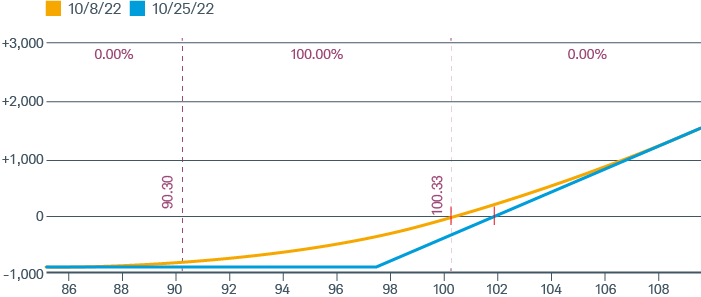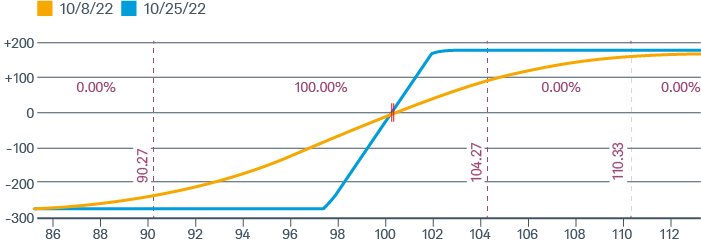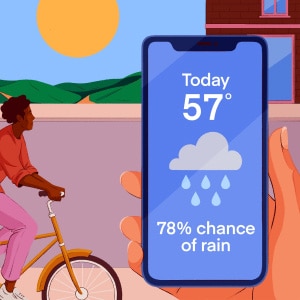
Bearish markets can cause dramatic swings in portfolio values, especially when large percentages are tied up in a few stocks. It is prudent to learn ways to temporarily protect your stock from a drop in price that is greater than you are willing to accept. If you are an option trader, one way of doing this with little to no out-of-pocket expense (not including transaction costs) is with an options strategy called a collar.
Besides the stock you are looking to protect, a collar consists of two options from the same expiration period: a long out-of-the-money (OTM) put and a short OTM call. A call option is OTM if its strike price is above the price of the underlying stock. Conversely, a put option is OTM if its strike price is below the price of the underlying stock. The premium collected by selling the call is used to help cover the cost of the put. If it helps, think about the collar as the combination of a covered call1 and a protective put2.
And remember—a standard options contract controls 100 shares of stock. So, you would buy one put and sell one call for every 100 shares of stock you wish to protect. Let us dissect the collar, beginning with the put option side of things.
Like all our strategy discussions, the following is strictly for educational purposes only. It is not, and should not be considered, individualized advice or a recommendation. Options trading involves unique risks and is not suitable for all investors. Collars and other multiple-leg options strategies can entail substantial transaction costs which may impact any potential return.
Buying a protective put
Long put options are not just for bearish traders. Buying puts can also be valuable if you are bullish and looking for a measure of short-term protection against an unforeseen drop in price.
Regarding strike price selection, there is no correct answer except to say your protection kicks in at your strike price. But the higher the put strike, the higher the premium you pay.
Say your stock is trading at $100.32, and you buy the 97.5 strike put for $1.61. You have now limited your potential loss to $4.43 (the $2.82 difference between the stock price and the strike price, plus the $1.61 you paid for the put, plus transaction costs.) Since the options multiplier is 100, your maximum loss is limited to $443, plus transaction costs.
Stock with protective put

For illustrative purposes only. Past performance does not guarantee future results.
Adding the covered call
While the cost of the put may not seem overly excessive relative to the price of the stock, buying the protection month after month (if you choose to) can add up. That's especially true if the implied volatility (IV), or the overall expectation, rises, suggesting the market is anticipating large movements. To lower the cost of buying the put, you can bring in a premium by selling an OTM call. Once all three pieces are in place (long stock, long OTM put, and short OTM call), you have the collar. For instance, say we sell the 102 strike call for $1.61, as shown below.
Stock collar

For illustrative purposes only. Past performance does not guarantee future results.
Selling a call about the same distance OTM as the put might bring about the same premium. But generally, it is likely to be less due to volatility skew—the IV of an OTM put tends to be higher than the OTM call. Usually, higher IV means a higher premium.
If you get the call to completely cover the cost of the put, as in the example above, then you have what is known as a "zero-cost" collar. Depending on your objectives, you can choose different strikes to get a price that works for you. The example above is a zero-cost collar, but to initiate it for zero cost, we were required to select a put strike that's further OTM than the call strike.
From floor to ceiling
Just as the put limits your risk should the stock price drop below your put strike, the short call caps your potential profit on the stock; you can think the put as a "floor" beneath your stock and the call as a "ceiling". Your choice of where you put the floor and ceiling determines your position's overall risk/reward.
Remember that you can raise the floor and ceiling by adjusting, giving your stock room to grow. Rolling your options to higher strikes and further out in time accommodates a stock that is still trending up. If both options are still OTM as expiration nears, you may be able to roll both options into deferred-month contracts to keep some protection in place.
And if the stock does indeed pull back below your put strike? You may be able to roll the put into another strike, or you could exercise your put, knowing that your loss was limited. Understand that rolling will entail additional transaction costs, which will impact any potential return.
1A covered call is a limited-return strategy constructed of a long stock and a short call. Ideally, you want the stock to finish at or below the call strike at expiration. If the stock price settles above the strike price, you'd have your stock called away at the short call strike. You'd keep your original credit from the sale of the call as well as any gain in the stock up to the strike. Breakeven on the trade is the stock price you paid minus the credit from the call and transaction costs.
2A protective put is an options strategy intended to guard against the loss of unrealized gains. The put option costs money, which reduces the investor's potential gains from owning the security, but it also reduces the risk of losing money if the underlying security declines in value.
Options carry a high level of risk and are not suitable for all investors. Certain requirements must be met to trade options through Schwab. Please read the Options Disclosure Document titled "Characteristics and Risks of Standardized Options" before considering any options transaction. Supporting documentation for any claims or statistical information is available upon request.
With long options, investors may lose 100% of funds invested. Covered calls provide downside protection only to the extent of the premium received and limit upside potential to the strike price plus premium received.
Short options can be assigned at any time up to expiration regardless of the in-the-money amount. Investing involves risks, including loss of principal. Hedging and protective strategies generally involve additional costs and do not assure a profit or guarantee against loss.
Commissions, taxes, and transaction costs are not included in this discussion but can affect final outcomes and should be considered. Please contact a tax advisor for the tax implications involved in these strategies.
The information provided here is for general informational purposes only and should not be considered an individualized recommendation or personalized investment advice. The investment strategies mentioned here may not be suitable for everyone. Each investor needs to review an investment strategy for his or her own particular situation before making any investment decision.
0423-2BD0

